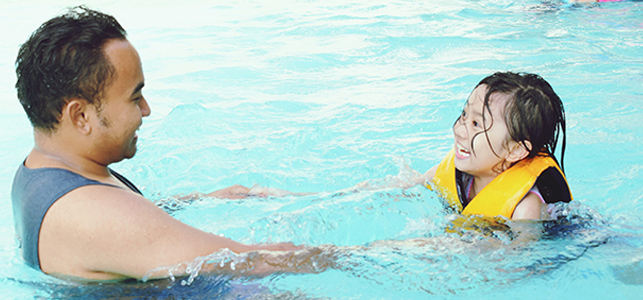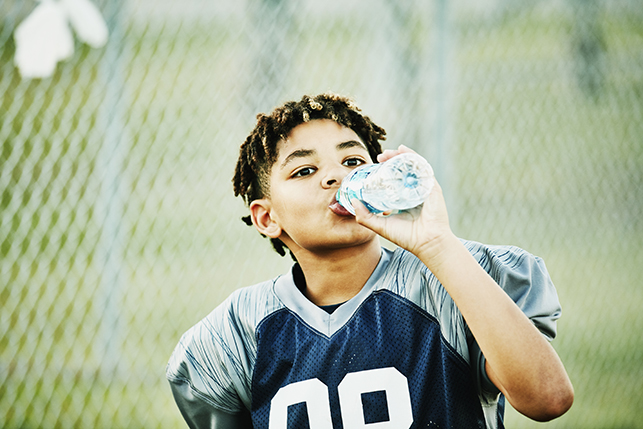
Summer’s here! Let’s make it a safe one with these summer safety tips
There’s a higher risk of certain injuries occurring during the summer months. Kids are out of school and active, families are traveling and trying new activities, and everyone’s attention is more relaxed – which isn’t always a good thing when it comes to safety.
Being prepared can help reduce safety risks. Here’s what you need to know so you can be aware of the risks, take precautions and share some important safety tips with your kids. Together, we can ensure your family is as safe as possible while enjoying the fun and new adventures summertime can bring.
1. Always watch closely and prepare kids for water fun
Drowning is the leading cause of death among preventable injuries for kids age 1-4. At this age, they’re more likely to drown in a pool. Over age 5, it’s natural or open water (lakes, rivers, oceans).
- Make sure an adult who’s a good swimmer watches kids WITHOUT DISTRACTIONS at all times. Keep young kids within arm’s reach and make sure older kids swim with a partner every time.
- Be aware of currents, the undertow and weather changes to watch for. Make sure your kids are aware of these too and know what to do and how to respond. Safe Kids draws attention to some common misconceptions about water safety.
- In 2018, 79 percent of those who drowned in boating accidents were not wearing a life jacket. A proper-fitting life jacket is “tops” in safe-boating tips and for water sports too. Life jackets save lives, and federal law requires that when a vessel is underway all children under age 13 wear a life jacket.
- ALWAYS have children wear a life jacket approved by the U.S. Coast Guard while on boats, around open bodies of water or when participating in water sports. Make sure it fits snugly. Have the child make a “touchdown” signal by raising both arms straight up; if the life jacket hits their chin or ears, it may be too big or the straps may be too loose.
- Swimming aids such as water wings or noodles are fun toys, but they should never be used in place of a U.S. Coast Guard-approved personal flotation device like a life jacket. Be sure your kids and all who care for them are aware of this. Also, according to the U.S. Coast Guard’s Office of Boating Safety, babies should not travel on a boat until they’re the appropriate weight to wear an approved personal flotation device. Read more boating safety recommendations.
2. Protect kids of all ages from heatstroke in hot vehicles
Heatstroke is the leading cause of non-crash, vehicle-related deaths for children. A car can heat up 19 degrees in just 10 minutes. On hot summer days this can happen even faster. Cracking a window does NOT help.
- NEVER leave your child alone in a car, not even for a minute. Make sure to keep your car doors locked when you’re not in it so kids don’t get in on their own. Make sure your trunk is always locked too.
- Teach kids that cars and trunks are NOT safe places to play and show older kids how to locate and use the emergency trunk release. For more safety tips, visit the heatstroke and trunk entrapment pages on the Safe Kids website.
3. Substitute sparklers and leave fireworks to the professionals
More than 3,000 kids end up in the ER each year in the U.S. due to fireworks, and sparklers are a leading cause. Though a popular go-to for summer celebrations and cookout fun, sparklers can heat up to 1,200 degrees and burn at a temperature hot enough to melt glass.
- Find a substitute for sparklers. Little arms are too short to safely hold them. Also, kids’ brains aren’t developed enough to fully understand the danger and keep them a safe distance from themselves and others. Try glow sticks or other light-up products instead. They come in lots of fun shapes and sizes and don’t burn at high temperatures. (Note: Young children should be closely supervised to be sure they don’t chew on these.)
- Above all, we recommend leaving all fireworks to the professionals. Go see a Fourth of July show instead.
4. Ensure safe seats for safe travel
Did you know that 73 percent of car seats are not used or installed correctly? Before your family hits the road this summer, check your kids’ car seats to be sure they’re A-OK. (Here’s a quick car seat checkup.) And whether you’re setting off on a vacation, visiting family or just heading somewhere in your neighborhood, be sure your family is as safe as possible when traveling.
- Buckling up on EVERY RIDE is the single most important thing a family can do to stay safe in the car.
- Children should remain in a safety seat with a harness as long as they fit the height and weight parameters of the seat. When they’re ready, use a booster seat with the vehicle lap and shoulder safety belts until your child passes the Safety Belt Fit Test.
- Kids are VIPs, and VIPs ride in the back seat. Keep all kids in the back seat until they are 13.
- If you’re flying, children can and should use a child safety seat that’s Federal Aviation Administration approved. Child safety seats have their own harness system and can be secured to an airplane seat using only a lap belt. (Note: This excludes booster seats because booster seats must be used with both a lap and shoulder belt, and airplane seats do not have shoulder belts.) Look for more on safe summer travel.
5. Make sure kids know what to do to defeat dehydration/heat illness
 Each year in the U.S. more than 9,000 high school athletes are treated for heat illness. Sports practices begin mid-summer. Exercising in hot, humid weather (more sweat!) increases risk of dehydration.
Each year in the U.S. more than 9,000 high school athletes are treated for heat illness. Sports practices begin mid-summer. Exercising in hot, humid weather (more sweat!) increases risk of dehydration.
- Encourage athletes to drink the right amount of water. The American Academy of Pediatrics recommends 5 ounces for an 88-pound child and 9 ounces for a 132-pound adolescent every 20 minutes of sports play. In more relatable terms for kids: In general, those in the 90-pound range should take 10 gulps of water every 20 minutes of play and older kids and teens (approximately 130-pound weight range) should drink about 20 gulps for the same time frame. Athletes will know they’re drinking enough water if their urine is clear or the color of lemonade.
- Teach your kids dehydration symptoms (muscle cramps, feeling dizzy/nauseous, rapid heartbeat) and that they need to tell their coach if they experience any of these.
6. Stop sun damage with sunscreen, physical blockers and limiting exposure
According to the AAP, most sun damage occurs in childhood, so children need to be protected from the sun’s burning rays. Take these precautions to protect your family’s skin:
- Use a sunscreen with a sun protection factor (SPF) higher than 30. It should be applied generously and reapplied every one-and-a-half to two hours. An adult-sized body needs one ounce of sunscreen; a smaller body requires a smaller amount, but it should adequately cover the body’s entire surface area. It’s important to wait 20 minutes after application before getting wet so the sunscreen has time to soak into the skin and form a protective layer.
- Though sunscreen is always recommended, the rate of skin cancer continues to rise despite sunscreen use. (It may be that sunscreen has provided a sense of security, so people are comfortable being in the sun for longer periods of time, leading to more exposure to the sun’s harmful rays.) For this reason, the American Academy of Dermatology also stresses the importance of physical blockers such as hats, sunglasses, clothing and shade, along with avoiding prolonged exposure to midday sun (10 a.m. - 3 p.m.). Check out these additional sun safety tips to protect your family.
7. Start summer with a safety equipment checkup and review
Every hour nearly 50 children visit emergency departments with injuries related to bikes, scooters, skates or skateboards. Summertime means more time in the daylight for these activities and it’s important to start the season with an equipment check-in and safety review.
- All bicyclists should wear a properly-fitted helmet EVERY TIME they ride. It’s the best way to prevent head injuries and death.
- A properly-fitted helmet should be worn at ALL TIMES by those on scooters, skates or skateboards. Knee pads and elbow pads are recommended for everyone, especially beginners. Wrist guards are also recommended for skaters and skateboarders. Teach kids to minimize the impact of a fall by crouching down as they lose balance to reduce the distance to the ground.
- The same helmet CANNOT safely be used for all activities. A child needs to wear the specific type of helmet for the sport or activity they’re participating in. Making sure each helmet fits correctly can increase their comfort and willingness to use it.
Here’s to a safe summer!
For more safety tips and resources, click here.
By Corri Miller-Hobbs, Safe Kids Virginia program coordinator
